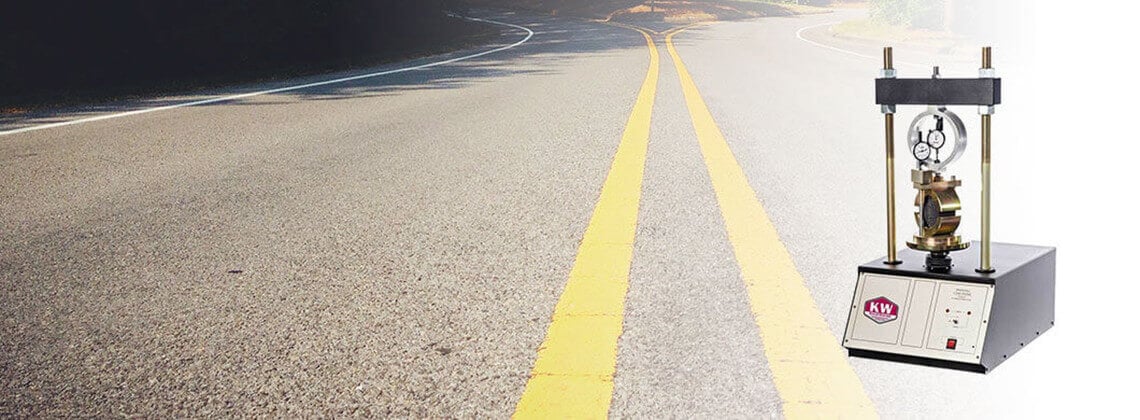Not all asphalt is created equal; otherwise, it couldn’t handle the necessary loads! Engineers can forecast the performance of an asphalt mixture and the maximum load it can support using the Marshall Test.
The Marshall method takes a comprehensive approach to designing the asphalt pavement mix. Through a series of processes, it can determine the optimal asphalt content for a mix that will provide its load with the highest strength and stability.
In this article, we’ll take you on an extensive exploration of the Marshall Test’s complexities, illuminating its relevance, the science behind it, and its practical uses in testing asphalt.
What is the Marshall Stability Test?
The “Marshall” in the Marshall Stability Test refers to the Marshall mix, the type of asphalt we see inroads today.
This method is a comprehensive strategy for asphalt pavement mix design. The Marshall mix design method helps engineers select the optimum asphalt binder content at a density that meets stability and flow value requirements.
While other tests have been developed and refined in conjunction with this test, the stability test is still one of the most widely used asphalt mix design methods worldwide.
Construction material laboratories frequently use the Marshall method of asphalt mix design to choose and proportion aggregate and asphalt components for pavement construction.
The selection of mineral aggregate and binder ingredients, the creation of trial samples, load testing for strength and flow test of materials, and lab tests of material properties are all part of this comprehensive method of designing asphalt pavement mixes.
The key is finding the optimal asphalt content to provide the mix with the most power and the least deformation from axle loads.
Trial mixtures of lab-mixed, lab-compacted (LMLC) asphalt mixtures are evaluated based on their density, the number of air spaces within the mix, the mineral aggregate, and the outcomes of Marshall stability and flow tests.
You may also like: Understanding the Specific Gravity of Asphalt
Background and History of the Marshall Test
The U.S. Army Corps of Engineers (USCOE) started examining several HMA mix design techniques for application in airfield pavement design during World War II.
The increasing wheel loads and tire pressures created by bigger and bigger military aircraft inspired this investigation.
The U.S. Army Waterways Experiment Station’s (WES) initial research efforts in 1943 aimed to develop a simple apparatus suitable for use with the current California Bearing Ratio (CBR) equipment to build and manage asphalt paving mixtures.
The Marshall Stability Method, developed by Bruce G. Marshall at the Mississippi Highway Department in 1939, ultimately proved to be the most promising technique.
Adding a deformation measurement (using a flow meter) to the original Marshall Stability Test by WES was made to help identify overly high asphalt contents. The U.S. Army was eventually advised to utilize this appended test because:
- Instead of just a small piece of the sample, the complete sample was intended to be stressed.
- It made quick testing possible with little effort.
- It was portable, lightweight, and small.
- It generated densities that were fairly similar to field densities.
Throughout the 1950s, WES tested various materials, traffic loads, and meteorological variables to improve the Marshall approach further.
Despite its drawbacks, the Marshall technique may be used to mix design, which is extensively utilized worldwide.
It is the most widely used because it is easy to use, affordable, and because the U.S. military adopted and used it worldwide during and after World War II.
Apparatus Used in the Marshall Test
Several specific tools and equipment are needed to carry out the Marshall Test. The following is a list of the main equipment used in the Marshall Test:
Marshall compaction apparatus
The Marshall Test’s major component is the Marshall Compaction Apparatus. It comprises a cylindrical mold with a typical diameter and height of 4 inches (101.6 mm) and 2.5 inches (63.5 mm). The asphalt specimens are prepared for testing using this mold.
Marshall compactor
A Marshall compactor compacts the asphalt samples in the cylindrical mold. A specified number of blows are applied to mimic the compaction process that asphalt goes through during construction (often 75 on each side).
Machine for Marshall stability testing
The maximum load (stability) an asphalt specimen can withstand before deforming or failing is ascertained using this equipment. It comprises a loading device, a proving ring, and a load frame with a moveable head. The proving ring measures the applied load.
Compaction pedestal
This platform ensures compaction is carried out precisely and consistently while supporting the Marshall compaction apparatus.
Marshall breaking head
This part places a vertical load on the asphalt specimen during the Marshall test.
Marshall plunger ejector
This plunger extracts the compacted asphalt specimen from the mold after compaction.
Marshall specimen extractor
This instrument removes The compressed specimen gently and damage-free from the mold.
Digital Displacement Transducer (DDT) or dial gauge
This is used to gauge how much the asphalt specimen deformed throughout the test. It offers information on the asphalt mix’s flow or deformation properties.
Read also: Asphalt Rice Testing: Understanding the Equipment and Tests
How to Perform the Marshall Mix Stability Test
While quite a few steps go into the Marshall test for asphalt, they’re straightforward to perform with the right equipment.
Step 1: Aggregate Selection
Asphalt is made of two main components: bitumen and aggregates. Bitumen is the liquid binder that holds the aggregate mix together, creating the final blend we know asphalt.
